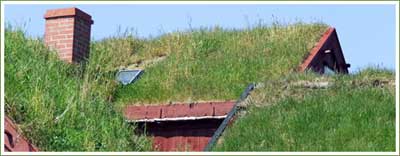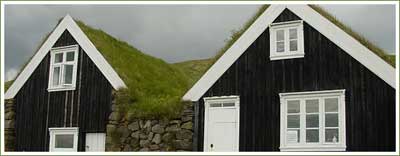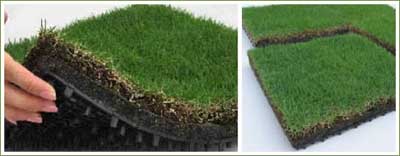By Philip Proefrock
Wed, 22 Aug 2007
It's not just for hobbits anymore. The logic of green roofs is becoming more apparent. We can minimize our bills while maximizing the beauty of the urban landscape. And every day it's becoming a little easier to live in a house that just happens to have plants growing on it.

Vegetated roofs, or green roofs have a layer of living plants on top of the structure and the waterproofing elements. There are really two types of green roofs, intensive and extensive.

Intensive green roofs often have a soil depth of a foot or more, and require substantial structural elements to support the weight of the whole roof. Intensive roofs can sustain a wide range of plant species and typically require a fair amount of regular maintenance. Because of the additional demands they impose, intensive roofs are much less common than extensive roofs.

Extensive roofs are much shallower, typically only 2 to 4 inches deep, and are planted with particularly hardy plants. Over the last 50 years or so, this kind of roof has been developed, specially in Europe,. But now they are becoming increasingly common in the United States.
Why are green roofs such a great idea?
First, they help to reduce roof stormwater runoff. In some cases, this can help reduce the size of stormwater pipes, and the amount of stormwater that needs to be treated by municipal water treatment. In a light rainfall, a building with a vegetated roof can have no stormwater runoff at all. Green roofs also protect the roof membrane from sunlight, which breaks down the roofing
material. Having even a couple inches of soil helps to greatly extend the life of the roof, and a longer lifespan means less material ends up in landfills from re-roofing buildings after the membranes have failed.

Green roofs keep the roof cooler, which helps to reduce the heat-island effect, which contributes to cities being hotter than the surrounding countryside. This can be beneficial to the building in reducing its summertime cooling load.
A green roof is also a source of oxygen and provides a habitat for some birds. Birds and insects can find homes much more readily in the living environment of a green roof, where an ordinary roof is nearly barren. And yes, it's even possible to graze goats.

What is a green roof made of?
Starting from the top, an extensive green roof has a layer of plants, which are typically sedums. These are low-growing, shallow rooting, drought tolerant plants. There are many different varieties of sedum, with different different coloration and different flowerings, so that a roof can have a varied appearance, rather than looking like an entire crop of a single variety. The plants are in a growth medium, an engineered mixture of lightweight soils, vermiculite, and other materials that provides a good environment for the sedum.
The shallow depth of the soil aids in keeping weeds from establishing themselves on the roof, since most weeds cannot survive in the arid and shallow soil conditions on a vegetated roof. Local plants that can survive in that environment may establish themselves on the roof, as well. Underneath the soil are several membrane layers, rather than just a single membrane roof. There is also a drainage layer (to allow excess water to move freely, rather than lifting the soil and having it flow off the roof in a mudslide, and a root barrier layer, which keeps the roots from penetrating the roof. The roof membrane sits on the roof deck, insulation, or structure of the building much like a conventional roof.

Can I put a green roof on my house?
Green roofs make sense for residential use as much as for commercial buildings. However, retrofitting a green roof onto an existing house is not a simple matter because of the extra weight a vegetated roof adds. Most roofs are not structurally strong enough to support a vegetated roof without some reinforcement. Green roofs also work best on lower slopes. They can be installed on steeper pitched roofs, but the design and installation is more difficult and
requires additional care.
The added cost of a vegetated roof versus a conventional shingle roof, and the relatively small number of contractors familiar with installing them are probably the biggest limiting factors. A house with a suitably pitched roof would still likely need structural evaluation from an architect or engineer before going ahead with a retrofit, and some structural reinforcement is likely
to be needed.

Does a green roof have to be mowed?
A sedum covered roof is naturally self limiting in size. Most sedums grow only a few inches tall. As mentioned above, it is also fairly self weeding, due to the inhospitable environment it offers to most weed species. An extensive roof planted with prairie grasses on the Ducks Unlimited National Headquarters in Winnipeg, Manitoba uses a controlled burn of its upper roof every three years to repropogate the prairie plants. The 16 inches of soil protects the building
from any damage while the grass fire helps remove weed species and assists prairie species which need periodic fires as part of their life cycle.
What Does the Future Hold?
We were excited a while back to announce Toyota's green roofing tile. These modular, interlockable grass tiles make green roofing an absolute cinch. They're a lot lighter than other methods, and installation is a breeze. At about $34 per tile, they're still expensive, but prices would of course drop if demand were to increase.

And, second, I and many others would like to see Friedenreich Hundertwasser's vision of every horizontal surface being returned to nature:
"The true proportions in this world are the views to the stars and the views down to the surface of the earth. Grass and vegetation in the city should grow on all horizontal spaces - that is to say, wherever rain and snow falls vegetation should grow, on the roads and on the roofs. The horizontal is the domain of nature and wherever vegetation grows on the horizontal level man is off limits; he should not interfere. I mean taking away territories from nature, which human beings have always done."

Green Roof Resources:
-The EPA on Green Roofs-Greenroofs.com-Green Roofs on Wikipedia-Green Roofs for Healthy
Cities-
Image Key:
1. Hundertwasser's Waldspirale, Austria...From WikiMedia Commons
2. Green Rooftops from Swishphotos on Flickr from the Faroe Islands
3. Grass Roof in Oswego Illinois, USA, from Greg Robbins on Flickr
4. Solaire Green Roof in Battery Park City, NY from Birdw0rks on Flickr
5. Goats on a Roof in Wisconsin, from Driftless Media on Flickr
6. Grass Roofs in Iceland from Pietroizzo on Flickr
7. Green Roof in Tokyo from Dissonanc3 on Flickr
8. Toyota Roof Tiles from Toyota Roof Garden
9. Hunderwasser's village model, on display at Kunsthaus in Vienna.













 Intel has announced a flash memory companion module for its forthcoming "Menlow" chipset for Linux-based mobile Internet devices (MIDs). The Z-P140 SSD (solid-state drive) measures 0.7 x 0.5 x 0.07 inches (18 x 12 x 1.8mm), and will be available in capacities up to 16GB.
Intel has announced a flash memory companion module for its forthcoming "Menlow" chipset for Linux-based mobile Internet devices (MIDs). The Z-P140 SSD (solid-state drive) measures 0.7 x 0.5 x 0.07 inches (18 x 12 x 1.8mm), and will be available in capacities up to 16GB. 





















